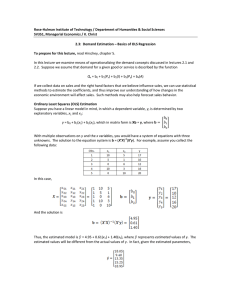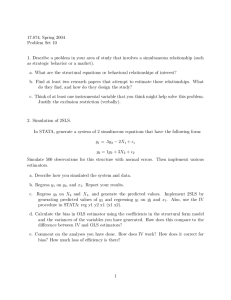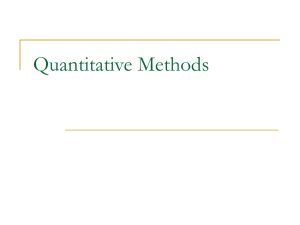Point-Based Planning for Multi-Objective POMDPs
advertisement
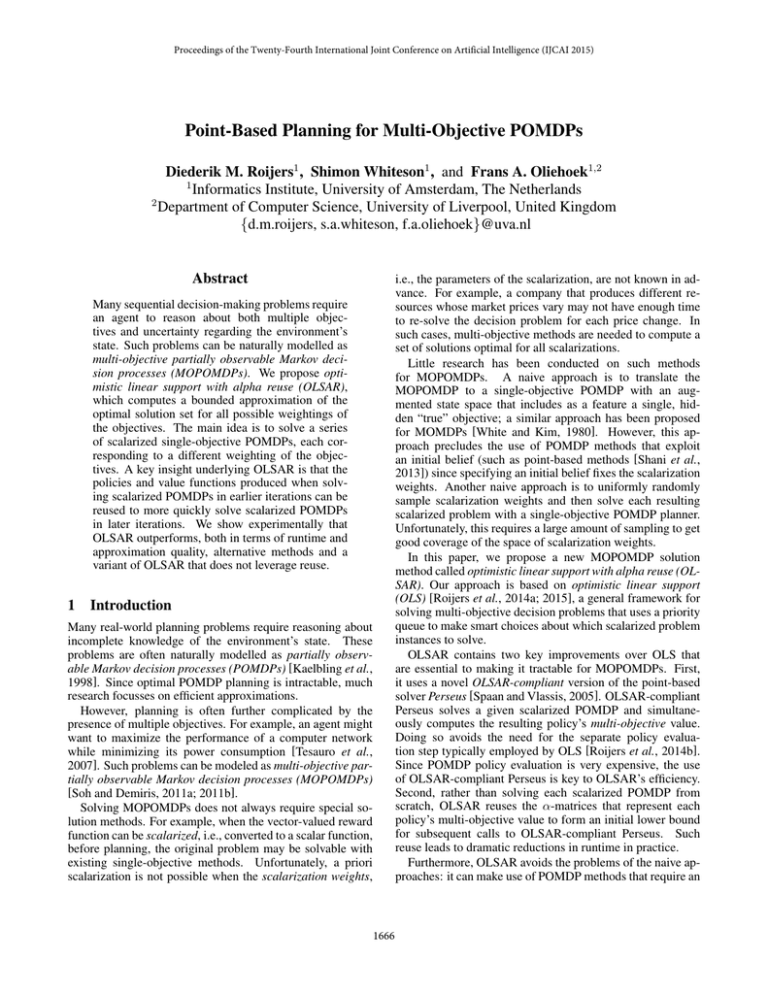
Proceedings of the Twenty-Fourth International Joint Conference on Artificial Intelligence (IJCAI 2015)
Point-Based Planning for Multi-Objective POMDPs
Diederik M. Roijers1 , Shimon Whiteson1 , and Frans A. Oliehoek1,2
1
Informatics Institute, University of Amsterdam, The Netherlands
2
Department of Computer Science, University of Liverpool, United Kingdom
{d.m.roijers, s.a.whiteson, f.a.oliehoek}@uva.nl
Abstract
i.e., the parameters of the scalarization, are not known in advance. For example, a company that produces different resources whose market prices vary may not have enough time
to re-solve the decision problem for each price change. In
such cases, multi-objective methods are needed to compute a
set of solutions optimal for all scalarizations.
Little research has been conducted on such methods
for MOPOMDPs. A naive approach is to translate the
MOPOMDP to a single-objective POMDP with an augmented state space that includes as a feature a single, hidden “true” objective; a similar approach has been proposed
for MOMDPs [White and Kim, 1980]. However, this approach precludes the use of POMDP methods that exploit
an initial belief (such as point-based methods [Shani et al.,
2013]) since specifying an initial belief fixes the scalarization
weights. Another naive approach is to uniformly randomly
sample scalarization weights and then solve each resulting
scalarized problem with a single-objective POMDP planner.
Unfortunately, this requires a large amount of sampling to get
good coverage of the space of scalarization weights.
In this paper, we propose a new MOPOMDP solution
method called optimistic linear support with alpha reuse (OLSAR). Our approach is based on optimistic linear support
(OLS) [Roijers et al., 2014a; 2015], a general framework for
solving multi-objective decision problems that uses a priority
queue to make smart choices about which scalarized problem
instances to solve.
OLSAR contains two key improvements over OLS that
are essential to making it tractable for MOPOMDPs. First,
it uses a novel OLSAR-compliant version of the point-based
solver Perseus [Spaan and Vlassis, 2005]. OLSAR-compliant
Perseus solves a given scalarized POMDP and simultaneously computes the resulting policy’s multi-objective value.
Doing so avoids the need for the separate policy evaluation step typically employed by OLS [Roijers et al., 2014b].
Since POMDP policy evaluation is very expensive, the use
of OLSAR-compliant Perseus is key to OLSAR’s efficiency.
Second, rather than solving each scalarized POMDP from
scratch, OLSAR reuses the α-matrices that represent each
policy’s multi-objective value to form an initial lower bound
for subsequent calls to OLSAR-compliant Perseus. Such
reuse leads to dramatic reductions in runtime in practice.
Furthermore, OLSAR avoids the problems of the naive approaches: it can make use of POMDP methods that require an
Many sequential decision-making problems require
an agent to reason about both multiple objectives and uncertainty regarding the environment’s
state. Such problems can be naturally modelled as
multi-objective partially observable Markov decision processes (MOPOMDPs). We propose optimistic linear support with alpha reuse (OLSAR),
which computes a bounded approximation of the
optimal solution set for all possible weightings of
the objectives. The main idea is to solve a series
of scalarized single-objective POMDPs, each corresponding to a different weighting of the objectives. A key insight underlying OLSAR is that the
policies and value functions produced when solving scalarized POMDPs in earlier iterations can be
reused to more quickly solve scalarized POMDPs
in later iterations. We show experimentally that
OLSAR outperforms, both in terms of runtime and
approximation quality, alternative methods and a
variant of OLSAR that does not leverage reuse.
1
Introduction
Many real-world planning problems require reasoning about
incomplete knowledge of the environment’s state. These
problems are often naturally modelled as partially observable Markov decision processes (POMDPs) [Kaelbling et al.,
1998]. Since optimal POMDP planning is intractable, much
research focusses on efficient approximations.
However, planning is often further complicated by the
presence of multiple objectives. For example, an agent might
want to maximize the performance of a computer network
while minimizing its power consumption [Tesauro et al.,
2007]. Such problems can be modeled as multi-objective partially observable Markov decision processes (MOPOMDPs)
[Soh and Demiris, 2011a; 2011b].
Solving MOPOMDPs does not always require special solution methods. For example, when the vector-valued reward
function can be scalarized, i.e., converted to a scalar function,
before planning, the original problem may be solvable with
existing single-objective methods. Unfortunately, a priori
scalarization is not possible when the scalarization weights,
1666
which returns, for each w, the maximal scalarized value
achievable for that weight. Finding this function is equivalent to finding the CCS and solving the decision problem.
∗
VCCS
(w) is a piecewise-linear and convex (PWLC) function
over weight space, a property that can be exploited to construct a CCS efficiently [Roijers et al., 2014a; 2015].
When the CCS cannot be computed exactly, an ε-CCS can
be computed instead. A set X is an ε-CCS is when the maximum scalarized error across all weights is at most ε:
initial belief but does not require inefficient sampling of the
scalarization weight space.
We show that OLSAR is guaranteed to find a bounded approximate solution in a finite number of iterations. In addition, we show experimentally that it outperforms uniform random sampling of scalarization weights, both with and without
α-matrix reuse, as well as OLS without α-matrix reuse.
2
Background
∗
∀w, VCCS
(w) − (max w · V) ≤ ε.
We start with background on multi-objective decision problems, POMDPs, MOPOMDPs, and OLS.
2.1
V∈X
2.2
Multi-Objective Decision Problems
Vb = max b · α.
α∈A
(4)
Each α-vector is associated with an action. Therefore, a set
of α-vectors A also provides a policy πA that for each belief
takes the maximizing action in (4).
While infinite-horizon POMDPs are in general undecidable [Madani et al., 2003], an ε-approximate value function
can in principle be computed using techniques like value iteration (VI) [Monahan, 1982] and incremental pruning [Cassandra et al., 1997]. Unfortunately, these methods scale
poorly in the number of states. However, point-based methods [Shani et al., 2013], which perform approximate backups
by computing the best α-vector only for a set B of sampled
beliefs, scale much better. For each b ∈ B, a point-based
backup is performed by first computing for each a and o, the
back-projection gia,o of each next-stage value vector αi ∈ Ak :
X
gia,o (s) =
O(a, s0 , o)T (s, a, s0 )αi (s0 ).
(5)
f (V, w) = w · V,
where w is a vector of non-negative weights that sum to 1. In
this case, a sufficient solution is the convex hull (CH), the set
of all undominated policies under a linear scalarization:
0
CH(Π) = {π : π∈Π ∧ ∃w∀(π 0∈Π) w·Vπ ≥ w·Vπ }, (1)
where Π is the set of allowed policies. However, the entire
CH may not be necessary. Instead, it also suffices to compute
a convex coverage set (CCS), a lossless subset of the CH. For
each possible w, a CCS contains at least one vector from the
CH that has the maximal scalarized value for w.
When f is not linear, we might require the Pareto front
(PF), a superset of the CH containing all policies for which
no other policy has a value that is at least equal in all objectives and greater in at least one objective. However, when
stochastic policies are allowed, all values on the PF can be
constructed from mixtures of CCS policies [Vamplew et al.,
2009]. Therefore, the CCS is inadequate only if the scalarization function is nonlinear and stochastic policies are forbidden. For simplicity, we assume linear scalarizations in this
paper. However, our methods are also applicable to nonlinear
scalarizations as long as stochastic policies are allowed.
Using the CCS, we can define a scalarized value function:
V∈CCS
POMDPs
An infinite-horizon single-objective POMDP [Kaelbling et
al., 1998; Madani et al., 2003] is a sequential decision problem that incorporates uncertainty about the state of the environment, and is specified as a tuple hS, A, R, T, Ω, O, γi
where S is the state space; A is the action space; R is the
reward function; T is the transition function, giving the probability of a next state given an action and a current state; Ω is
the set of observations; O is the observation function, giving
the probability of each observation given an action and the
resulting state; and γ is the discount factor.
Typically, an agent maintains a belief b over which state it
is in. The value function for a single-objective POMDP, Vb , is
defined in terms of this belief and can be represented by a set
A of α-vectors. Each vector α (of length |S|) gives a value
for each state s. The value of a belief b given A is:
In single-objective decision problems, an agent must find a
policy π that maximizes V , the expected value of, e.g., a sum
of discounted rewards. In multi-objective decision problems,
there are n objectives, yielding a vector-valued reward function. As a result, each policy has a vector-valued expected
value V and, rather than having a single optimal policy, there
can be multiple policies whose value vectors are optimal for
different preferences over the objectives. Such preferences
can be expressed using a scalarization function f (V, w) that
is parameterized by a parameter vector w and returns Vw ,
the scalarized value of V. When w is known beforehand,
it may be possible to a priori scalarize the decision problem
and apply standard single-objective solvers. However, when
w is unknown during planning, we need an algorithm that
computes a set of policies containing at least one policy with
maximal scalarized value for each possible w.
Which policies should be included in this set depends on
what we know about f , as well as which policies are allowed.
In many real-world problems, f is linear, i.e.,
∗
VCCS
(w) = max w · V,
(3)
s0 ∈S
This step is identical for (and can be shared amongst) all b ∈
B. For each b, the back-projected vectors gia,o are used to
construct |A| new α-vectors (one for each action):
X
b,a
αk+1
= ra + γ
arg max b · g a,o ,
(6)
o∈Ω
g a,o
where ra is a vector containing the immediate rewards for
b,a
performing action a in each state. Finally, the αk+1
that maximizes the inner product with b (cf. (4)) is retained as the new
α-vector for b:
b,a
backup(Ak , b) = arg max b · αk+1
.
(2)
αb,a
k+1
1667
(7)
Vb (w) = max bAw.
A∈A
8
6
(1,8)
(7,2)
(5,6)
2
Vw
4
6
(7,2)
Vw
4
Δ
2
wc
0.0
0.2
0.4 0.6
w1
0
MOPOMDPs
A MOPOMDP [Soh and Demiris, 2011b] is a POMDP with
a vector-valued reward function R instead of a scalar one.
The value of a MOPOMDP policy given an initial belief b0 is
thus also a vector Vb0 . The scalarized value given w is then
w·Vb0 . Note that in an MOPOMDP, a nonlinear scalarization
would make it impossible to construct a POMDP model for a
particular w, since a nonlinear f does not distribute over the
expected sum of rewards. Therefore, nonlinear scalarization
would preclude the application of dynamic-programmingbased POMDP methods [Roijers et al., 2013].
Because R is vector valued, each element of each α-vector,
i.e., each α(s), is itself a vector, indicating the value in all
objectives. Thus, each α-vector is actually an α-matrix A
in which each row A(s) represents the multi-objective value
vector for s. The multi-objective value of taking the action
associated with A under belief b (provided as a row vector)
is then bA. When w is also given (as a column vector), the
scalarized value of taking the action associated with A under
belief b is bAw. Given a set of α-matrices A that approximates the multi-objective value function, we can thus extract
the scalar value given a belief b for every w:
0.8
1.0
0.0
0.2
0.4 0.6
w1
0.8
1.0
Figure 1: Finding value vectors, corner weights, and the maximal possible improvement for a partial CCS X in OLS.
however, OLS selects the weight vectors w instances intelligently. In order to select good w’s for scalarization, OLS exploits the observation that VX∗ (w) is PWLC over the weight
simplex. In particular, OLS selects only so-called corner
weights that lie at the intersections of line segments of the
PWLC function VX∗ (w) that correspond to the value vectors
found so far. OLS prioritizes these corner weights according
to an optimistic estimate of their potential error reduction.
First, let us assume OLS has access to an optimal singleobjective solver. For this case, the workings of OLS are illustrated for a 2-objective problem in Figure 1. The first
corner weights (denoted with red vertical line segments) are
the extrema of the weight simplex. On the left, OLS finds
an optimal value vector for both extrema: (1, 8) and (7, 2).
After finding these first two value vectors, OLS identifies a
new corner weight: wc . At this corner weight, the maximal possible improvement consistent with scalarized values
found at the extrema of the weight simplex is ∆. OLS now
calls the single-objective solver for wc , and discovers a new
value vector, (5, 6), leading to two new corner weights. OLS
first processes the corner weight with the largest ∆, which is
an optimistic estimate of the error reduction that processing
that corner weight will yield. In Figure 1 (right), OLS selects
the corner weight on the right, because its maximal possible
improvement, ∆, is highest.
If no improving value vector for a corner weight is found
by the single-objective solver, the value for that corner weight
is optimal, and no new corner weights are generated. When
none of the remaining corner weights yield an improvement,
the intermediate set X is a CCS and OLS terminates.
When the single-objective solver is exact, OLS is thus
guaranteed to produce an exact CCS after a finite number of
calls to the single-objective solver. Furthermore, even when a
bounded approximate single-objective solver is used instead,
OLS retains this quality bound.
(8)
Since each α-matrix is associated with a certain action, a polw
icy πA
can be distilled from A given w. The multi-objective
value for a given b0 under policy π is denoted Vbπ0 = b0 A.
A naive approach to solving MOMDPs, which we refer to
as random sampling (RS) [Roijers et al., 2014b], was introduced in the context of multi-objective MDPs. RS samples
many w’s and creates a scalarized POMDP according to each
w. Unless some prior knowledge about w is available, sampling is uniformly random. Each scalarized POMDP can then
be solved with any POMDP method, including point-based
ones. The resulting multi-objective value vectors are maintained in a set X, which forms a lower bound on the scalarized value function:
VX∗ (w) = max w · V.
V∈X
An important downside of this method is that although X will
converge to the CCS in the limit, we do not know when this
is the case. Furthermore, because w are sampled at random,
RS might do a lot of unnecessary work.
2.4
(1,8)
0
2.3
8
Point-based methods typically perform several point-based
backups using Ak for different b to construct the set of αvectors for the next iteration, Ak+1 . By constructing the αvectors only from the g a,o that are maximizing for the given
b, point-based methods avoid generating the much larger set
of α-vectors that an exhaustive backup of Ak would generate.
Lemma 1. Given an ε-optimal approximate single-objective
solver, OLS produces an ε-CCS [Roijers et al., 2014b].
Optimistic Linear Support
This paper builds on optimistic linear support (OLS) [Roijers
et al., 2014a; 2015] — a general scheme for solving multiobjective decision problems. Like RS, OLS repeatedly calls
a single-objective solver to solve scalarized instances of the
multi-objective problem and maintains a set X that forms a
lower bound on the value function VX∗ (w). Contrary to RS
3
OLS with Alpha Reuse
We now present our main contribution, a new algorithm
for MOPOMDPs called optimistic linear support with alpha
reuse (OLSAR). OLSAR builds on OLS but significantly improves it in two ways. First, by reusing the results of earlier
1668
form a lower bound on the (multi-objective) value (line 9).
Initially, this lower bound is a heuristic lower bound. In the
single-objective case, this usually consists of a minimally realisable value heuristic, in the form of α-vectors. In order to
enable α-reuse for the multi-objective version, these heuristics must be in the form of α-matrices. For example, if we
i
denote the minimal reward for each objective i as Rmin
, one
lower bound heuristic α-matrix Amin is the vectors consisti
ing of Rmin
/(1 − γ) for each objective and state.
OLSAR selects the maximizing α-matrix (2) for each belief b ∈ B and the given w and puts them in a set Ar . Using
Ar , OLSAR calls solveScalarizedPOMDP. After obtaining
a new set of α-matrices Aw from solveScalarizedPOMDP,
OLSAR calculates Vb0 ; the maximizing multi-objective
value vector for b0 at w (line 11). If Vb0 is an improvement
to X (line 14), OLSAR adds it to X and calculates the new
corner weights and their priorities.
A key insight behind OLSAR is that if we can retrieve the α-matrices underlying the policy found by
solveScalarizedPOMDP for a specific w, we can reuse
these α-matrices as a lower bound for subsequent calls to
solveScalarizedPOMDP with another weight w0 . Especially when w and w0 are similar, we expect this lower bound
to be close to the α-matrices required for w0 .
However, to exploit this insight, solveScalarizedPOMDP
must return the α-matrices explicitly, not just the scalarized value or the single-objective α-vectors, as standard
single-objective solvers do. A naive way to retrieve the αmatrices is to perform a separate policy evaluation on the policy returned by solveScalarizedPOMDP. However, since
POMDP policy evaluation is expensive, we instead require
solveScalarizedPOMDP to be OLSAR-compliant: i.e., to
return a set of α-matrices, while computing the same scalarized value function as a single-objective solver. We propose
an OLSAR-compliant solver in Section 3.1.
The α-matrix reuse enabled by an OLSAR-compliant subroutine is key to solving MOPOMDPs efficiently. Intuitively,
the corner weights that OLSAR selects lie increasingly closer
together as the algorithm iterates. Consequently, the policies and value functions computed for those weights lie
closer together as well and solveScalarizedPOMDP needs
less and less time to improve upon the α-matrices that begin increasingly close to their converged values. In fact,
late in the execution of OLSAR, corner weights are tested
that yield no value improvement, i.e., no new α-matrices
are found. These tests serve only to confirm that the CCS
has been found, rather than to improve it. While such
confirmation tests would be expensive in OLS, in OLSAR
they are trivial: the already present α-matrices suffice and
solveScalarizedPOMDP converges immediately. As we
show in Section 4, this greatly reduces OLSAR’s runtime.
Algorithm 1: OLSAR(b0 , η)
1
2
3
4
5
6
7
8
9
10
11
12
13
14
15
16
17
18
19
20
Input:
X
← ∅;A POMDP
// partial CCS of multi-objective value vectors Vb0
W Vold ← ∅;
// searched weights and scalarized values
Q ← priority queue with weights to search;
Add extrema of the weight simplex to Q with infinite priority;
Aall ← a set of α-matrices forming a lower bound on the value;
B ← set of sampled belief points (e.g., by random exploration);
while ¬Q.isEmpty() ∧ ¬timeOut do
w ← Q.dequeue();
// Retrieve a weight vector
Ar ← select the best A from Aall for each b ∈ B, given w;
Aw ← solveScalarizedPOMDP(Ar , B, w, η);
Vb0 ← maxA∈Aw b0 Aw;
Aall ← Aall ∪ Aw ;
W Vold = W Vold ∪ {(w, w · Vb0 )};
if Vb0 6∈ X then
X ← X ∪ {Vb0 };
W ← compute new corner weights and maximum
possible improvements (w, ∆w ) using W Vold and X;
Q.addAll(W );
end
end
return X;
iterations, OLSAR greatly speeds up later iterations. Second,
by using an OLSAR-compliant point-based solver as a subroutine, it obviates the need for separate policy evaluations.
We first describe OLSAR and specify the criteria that the
single-objective POMDP method that OLSAR calls as a subroutine, which we call solveScalarizedPOMDP, must satisfy to be OLSAR-compliant. Then, Section 3.1 describes
an instantiation of solveScalarizedPOMDP that we call
OLSAR-Compliant Perseus. Finally, Section 3.2 discusses
OLSAR’s theoretical properties, which leverage existing theoretical guarantees of point-based methods and OLS.
OLSAR maintains an approximate CCS, X, and thereby
an approximate scalarized value function VX∗ . By extend∗
.
ing X with new value vectors Vb0 , VX∗ approaches VCCS
The vectors Vb0 are computed using sets of α-matrices. OLSAR finds these sets of α-matrices by solving a series of
scalarized problems, each of which is a decision problem
over belief space for a different weight w. Each scalarized problem is solved by a single-objective solver we call
solveScalarizedPOMDP, which computes the value function of the MOPOMDP scalarized by w.
OLSAR, given in Algorithm 1, takes an initial belief b0
and a convergence threshold η as input. The value vectors Vb0 found for different w are kept in a partial approximate CCS, X (line 1). OLSAR keeps track of which w
have been searched and the associated scalarized values in
a set of tuples W Vold (line 2). The weights that still need
to be investigated are kept in a priority queue Q, and prioritized by their maximal possible improvement ∆w (lines 3–4),
which is calculated via a linear program [Roijers et al., 2014a;
2015]. OLSAR also maintains Aall , a set of all α-matrices returned by calls to solveScalarizedPOMDP to reuse (line 5)
and B, a set of sampled beliefs (line 6).
In the main loop, (lines 7–18) OLSAR repeatly pops a corner weight off the queue. For each popped w, it selects the
α-matrices from Aall to initialize Ar , a set of α-matrices that
3.1
OLSAR-Compliant Perseus
OLSAR requires an OLSAR-compliant implementation of
solveScalarizedPOMDP that returns the multi-objective
value of the policy found for a given w. This requires redefining the point-based backup such that it returns an α-matrix
rather than an α-vector. Starting from a set of α-matrices Ak ,
we now perform a backup for a given b and w. As in (9), the
1669
the density δB of the sampled belief set, i.e., the maximal
distance from the closest b ∈ B to any other belief in the
belief set [Pineau et al., 2006].
Algorithm 2: OCPerseus(A, B, w, η)
1
2
3
4
5
6
7
8
0
Input:
A POMDP
A
← A;
A ← {−∞};
~
// worst possible vector in a singleton set
while maxb maxA0 ∈A0 bA0 w − (maxA∈A bAw) > η do
A ← A0 ; A0 ← ∅ ; B 0 ← B;
while B 0 6= ∅ do
Randomly select b from B’;
A ← backupMO(A, b, w);
A0 ← A0 ∪ { arg max bA0 w};
Lemma 2. The error ε on the lower bound of the value of
an infinite-horizon POMDP after convergence of point-based
methods is:
δB (Rmax − Rmin )
,
(12)
ε≤
(1 − γ)2
A0 ∈(A∪{A})
A∈A
A ∈A
end
10
11
12
where Rmax and Rmin are the maximal and minimal possible
immediate rewards [Pineau et al., 2006].
B 0 ← {b ∈ B 0 : max
bA0 w < max bAw};
0
0
9
Using Lemma 2 we can bound the error of the approximate
CCS computed by OLSAR.
end
return A0 ;
Theorem 1. OLSAR implemented with OCPerseus using belief set B converges in a finite number of iterations to an εmax −Rmin )
CCS, where ε ≤ δB (R(1−γ)
.
2
new backup first computes the back-projections Ga,o
(for all
i
a, o) of each next-stage α-matrix Ai ∈ Ak . However, these
Ga,o
are now matrices instead of vectors:
i
X
Ga,o
O(a, s0 , o)T (s, a, s0 )Ai (s0 ).
(9)
i (s) =
Proof. Because OLSAR follows the same iterative process as OLS, Lemma 1 applies to it, i.e., it converges after finite calls to solveScalarizedPOMDP. Because OCPerseus
differs from regular Perseus only in that it returns the multiobjective value rather than just the scalarized value, Lemma
2 also holds for OCPerseus for any w. In other words,
OCPerseus is an ε-approximate single-objective solver, with
ε as specified by Lemma 2. Therefore, it follows that OLSAR
produces an ε-CCS. A nice property of OLSAR is thus that it inherits any quality guarantees of the solveScalarizedPOMDP implementation it uses. Better initialization of OCPerseus due to αmatrix reuse does not effect the guarantees in any way. On the
contrary, it affects only empirical runtimes. The next section
presents experimental results that measure these runtimes.
s0 ∈S
As before, the back-projected matrices Ga,o
are identical for
i
(and can be shared amongst) all b ∈ B. For the given b and
w, the back-projected matrices are used to construct |A| new
α-matrices (one for each action):
X
a
Ab,a
arg max b Ga,o w.
(10)
k+1 = r + γ
o∈Ω
Ga,o
Note that the vectors Ga,o w can also be shared between all
b ∈ B. Therefore, we cache the values of Ga,o w.
Finally, the Ab,a
k+1 that maximizes the scalarized value
given b and w is selected by the backupMO operator:
backupMO(Ak , b, w) = arg max bAa,b
k+1 w.
4
(11)
Ab,a
k+1
In this section, we empirically compare OLSAR to three
baseline algorithms. The first is random sampling (RS),
described in Section 2.3, which does not use OLS or
alpha reuse. The second is random sampling with alpha reuse (RAR), which does not use OLS. The third is
OLS+OCPerseus, which does not use alpha reuse. We
tested the algorithms on three MOPOMDPs based on the
Tiger [Cassandra et al., 1994] and Maze20 [Hauskrecht,
2000] benchmark POMDPs. Because we use infinite-horizon
MOPOMDPs – which are undecidable – we cannot obtain the
true CCS. Therefore, we compare our algorithms’ solutions to
reference sets obtained by running OLSAR with many more
sampled belief points and η set 10 times smaller.
We can plug backupMO into any point-based method. In
this paper, we use Perseus [Spaan and Vlassis, 2005] because
it is fast and can handle large sampled belief sets. The resulting OLSAR-compliant Persues is given in Algorithm 2. It
takes as input an initial lower bound A on the value function
in the form of a set of α-matrices, a set of sampled beliefs,
a scalarization weight w, and a precision parameter η. It repeatedly improves this lower bound (lines 3-10) by finding
an improving α-matrix for each sampled belief. To do so, it
selects a random belief from the set of sampled beliefs (line
6) and, if possible, finds an improving A for it (line 7). When
such an α-matrix also improves the value for another belief
point in B, this belief point is ignored until the next iteration
(line 9). This results in an algorithm that generates few αmatrices in early iterations, but improves the lower bound on
the value function, and gets more precise, i.e., generates more
α-matrices, in later iterations.
3.2
Experiments
4.1
Multi-Objective Tiger Problem
In the Tiger problem [Cassandra et al., 1994], an agent faces
two doors: behind one is a tiger and behind the other is treasure. The agent can listen or open one of the doors. When it
listens, it hears the tiger behind one of the doors. This observation is accurate with probability 0.85. Finding the treasure,
finding the tiger, and listening yield rewards of 10, -100, and
-1, respectively. We use a discount factor of γ = 0.9.
Analysis
Point-based methods like Perseus have guarantees on the
quality of the approximation. These guarantees depend on
1670
We let OLS+COPerseus run for 11 hours but it did not converge in that time. OLS+OCPerseus, RS, and RAR have similar performance after around 300 minutes. However, until
then, OLS+OCPerseus does better (and unlike RS and RAR,
OLS+OCPerseus is guaranteed to converge). OLSAR converges at significantly less error than what the other methods
have attained after 400 minutes. We therefore conclude that
OLSAR reduces error more quickly than the other algorithms
and converges faster than OLS+OCPerseus.
While the single-objective Tiger problem assumes all three
rewards are on the same scale, it is actually difficult in practice to quantify the trade-offs between, e.g., risking an encounter with the tiger and acquiring treasure. In two-objective
MO-Tiger (Tiger2), we assume that the treasure and the cost
of listening are on the same scale but treat avoiding the tiger
as a separate objective. In three-objective MO-Tiger (Tiger3),
we treat all three forms of reward as separate objectives.
We conducted 25 runs of each method on both Tiger2 and
Tiger3. We ran all algorithms with 100 belief points generated by random exploration, η = 1 × 10−6 , and b0 set to a
uniform distribution. The reference set was obtained using
250 belief points.
On Tiger2 (Figure 2(a)), OLS+OCPerseus converges in
0.87s on average, with a maximal error in scalarized value
across the weight simplex w.r.t. the reference set of 5 × 10−6 .
OLSAR converges significantly faster (t-test: p < 0.01), in
on average 0.53s, with similar error 4 × 10−6 (this difference
in error is not significant). RAR does not converge as it just
keeps sampling new weights. However, we can measure error w.r.t. the reference set. After 2s (about four times what
OLSAR needs to converge), RAR has an error with respect
to the reference set of 4.5 × 10−3 (a factor of 103 higher than
OLSAR after convergence). RS is even worse and does not
come further than a 0.78 error after 2s. OLS+OCPerseus and
OLSAR perform similarly in the first half: they use about
the same time on the first four iterations (0.35s). However,
OLSAR is significantly faster for the second half. Thus, on
Tiger2, OLS-based methods are significantly better than random sampling and alpha reuse significantly speeds the discovery of good value vectors.
The results for the Tiger3 problem are in Figure 2(b). RS
and RAR both perform poorly, with RAR better by a factor of two. OLS+OCPerseus is faster than RAR but OLSAR
is the fastest and converges in about 2s. OLS+OCPerseus
eventually converges to the same error but takes 10 times
longer. As before, OLS-based methods outperform random
sampling. Furthermore, for this 3-objective problem, alpha
reuse speeds convergence of OLSAR by an order of magnitude.
4.2
5
Related Work
As previously mentioned, little research has been done on the
subject of MOPOMDPs. White and Kim (1980) proposed a
method to translate a multi-objective MDP into a POMDP,
which can also be applied to a MOPOMDP and yields a
single-objective POMDP. Intuitively, this translation assumes
there is only one “true” objective. Since the agent does not
know which objective is the true one, this yields a singleobjective POMDP whose state is a tuple hs, di where s is
the original MOPOMDP state and d ∈ {1 . . . n} indicates
the true objective. The POMDP’s state space is of size |S|n.
The observations provide information about s but not about d.
The resulting POMDP can be solved with standard methods
but only those that do not require an initial belief, as such a
belief would fix not only a distribution over s but also over d,
yielding a policy optimal only for a given w. Since this precludes efficient solvers like point-based methods, it is a severe
limitation. We tested this method, and it proved prohibitively
computationally expensive for even the smallest problems.
Other research on MOPOMDPs [Soh and Demiris, 2011a;
2011b] uses evolutionary methods to approximate the PF.
However, no guarantees can be given on the quality of the approximation. Furthermore, as discussed in Section 2.1, finding a PF is only necessary when the scalarization function is
nonlinear and stochastic policies are forbidden. In this paper,
we focus on finding bounded approximations of the CCS.
6
Conclusions & Future Work
In this paper we proposed, analyzed, and tested OLSAR, a
novel algorithm for MOPOMDPs that intelligently selects
a sequence of scalarized POMDPs to solve. OLSAR uses
OCPerseus, a scalarized MOPOMDP solver that returns the
multi-objective value of the policies it finds, as well as the
α-matrices that describe them. A key insight underlying OLSAR is that these α-matrices can be reused in subsequent
calls to OCPerseus, greatly reducing runtimes in practice.
Furthermore, since OCPerseus returns ε-optimal polcies, OLSAR is guaranteed in turn to return an ε-CCS. Finally, our
experiments results show that OLSAR greatly outperforms
alternatives that do not use OLS and/or α-matrix reuse.
In future work, we aim to extend OLSAR to make use of
upper bounds as well as lower bounds, in the style of POMDP
methods such as GapMin [Poupart et al., 2011] or SARSOP
[Kurniawati et al., 2008]. Furthermore, it has been shown
that the solution to a constrained POMDP (CPOMDP) —
in which one primary objective must be maximized while
bounding the value of one or more additional objectives —
Multi-Objective Maze20 Problem
In Maze20 [Hauskrecht, 2000], a robot must navigate through
a 20-state maze. It has four actions to move in the cardinal
directions, plus two sensing actions to perceive walls in the
north-south or east-west directions. Transitions and observations are stochastic. In the single-objective problem, the agent
gets reward of 2 for sensing, 4 for moving while avoiding the
wall, and 150 for reaching the goal. In multi-objective Maze
20 (MO-Maze20), the reward for reaching the goal is treated
as a separate objective, yielding a two-objective problem.
To test performance of OLSAR on MO-Maze20, we first
created a reference set by letting OLSAR converge using
1500 sampled beliefs. This took 11 hours. Then we ran OLSAR, OLS+OCPerseus, RAR, and RS with 1000 sampled
beliefs. Due to the computational expense, we conducted
only three runs per method. Figure 2(c) shows the results.
OLSAR converges after (on average) 291 minutes (4.90hrs)
at an error of 0.09, less than 0.5% w.r.t. the reference set.
1671
1e+02
10.0
RAR
ε
OLSAR
1.0
ε
OLS+
0.1
1e-04
ε
1e-01
1e-04 1e-02 1e+00
RS
500
1000
1500
runtime (ms)
(a)
2000
500
1000 1500 2000 2500
runtime (ms)
(b)
100
200
300
runtime (min)
400
(c)
Figure 2: The error with respect to a reference set as a function of the runtime for (a) Tiger 2, (b) Tiger3, and (c) MO-Maze20.
The shaded regions represent standard error. Note the log scale in the y-axis. In order to avoid clutter in the plot (due to the
log-scale) we only show the standard error above the lines.
[Poupart et al., 2015] P. Poupart, A. Malhotra, P. Pei, K.E. Kim,
B. Goh, and M. Bowling. Approximate linear programming for
constrained partially observable Markov decision processes. In
AAAI, 2015.
[Roijers et al., 2013] D.M. Roijers, P. Vamplew, S. Whiteson, and
R. Dazeley. A survey of multi-objective sequential decisionmaking. JAIR, 47:67–113, 2013.
[Roijers et al., 2014a] Diederik M. Roijers, Shimon Whiteson, and
Frans A. Oliehoek. Linear support for multi-objective coordination graphs. In AAMAS, pages 1297–1304, May 2014.
[Roijers et al., 2014b] D.M. Roijers, J. Scharpff, M.T.J. Spaan, F.A.
Oliehoek, M.M. de Weerdt, and S. Whiteson. Bounded approximations for linear multi-objective planning under uncertainty. In
ICAPS, pages 262–270, 2014.
[Roijers et al., 2015] Diederik M Roijers, Shimon Whiteson, and
Frans A Oliehoek. Computing convex coverage sets for faster
multi-objective coordination. JAIR, 52:399–443, 2015.
[Shani et al., 2013] G. Shani, J. Pineau, and R. Kaplow. A survey
of point-based POMDP solvers. JAAMAS, 27(1):1–51, 2013.
[Soh and Demiris, 2011a] H. Soh and Y. Demiris. Evolving policies for multi-reward partially observable Markov decision processes (MR-POMDPs). In GECCO, pages 713–720, 2011.
[Soh and Demiris, 2011b] H. Soh and Y. Demiris. Multi-reward
policies for medical applications: Anthrax attacks and smart
wheelchairs. In GECCO, pages 471–478, 2011.
[Spaan and Vlassis, 2005] M.T.J. Spaan and N. Vlassis. Perseus:
Randomized point-based value iteration for POMDPs. JAIR,
pages 195–220, 2005.
[Tesauro et al., 2007] G. Tesauro, R. Das, H. Chan, J. O. Kephart,
C. Lefurgy, D. W. Levine, and F. Rawson. Managing power
consumption and performance of computing systems using reinforcement learning. In NIPS, 2007.
[Vamplew et al., 2009] P. Vamplew, R. Dazeley, E. Barker, and
A. Kelarev. Constructing stochastic mixture policies for episodic
multiobjective reinforcement learning tasks. In Advances in Artificial Intelligence, pages 340–349. 2009.
[White and Kim, 1980] C. C. White and K. M. Kim. Solution procedures for solving vector criterion Markov decision processes.
Large Scale Systems, 1:129–140, 1980.
corresponds to the solution of an MOPOMDP linearly scalarized according to some w [Poupart et al., 2015]. Using this
result, we aim to investigate how an ε-CCS computed by OLSAR could be used to explore what sets of constraints are
feasible in a CPOMDP.
Acknowledgments
This research is supported by NWO DTC-NCAP
(#612.001.109) project and the NWO Innovational Research Incentives Scheme Veni (#639.021.336).
References
[Cassandra et al., 1994] A.R. Cassandra, L.P. Kaelbling, and M.L.
Littman. Acting optimally in partially observable stochastic domains. In AAAI, volume 94, pages 1023–1028, 1994.
[Cassandra et al., 1997] A.R. Cassandra, M.L. Littman, and N.L.
Zhang. Incremental pruning: A simple, fast, exact method for
partially observable Markov decision processes. In UAI, pages
54–61, 1997.
[Hauskrecht, 2000] M. Hauskrecht. Value-function approximations
for partially observable Markov decision processes. JAIR, 13:33–
94, 2000.
[Kaelbling et al., 1998] L.P. Kaelbling, M.L. Littman, and A.R.
Cassandra. Planning and acting in partially observable stochastic
domains. Artificial Intelligence, 101:99–134, 1998.
[Kurniawati et al., 2008] H. Kurniawati, D. Hsu, and W.S. Lee.
SARSOP: Efficient point-based POMDP planning by approximating optimally reachable belief spaces. In Robotics: Science
and Systems, 2008.
[Madani et al., 2003] O. Madani, S. Hanks, and A. Condon. On
the undecidability of probabilistic planning and related stochastic
optimization problems. AIJ, 147(1):5–34, 2003.
[Monahan, 1982] G.E. Monahan. State of the art — a survey of
partially observable Markov decision processes: theory, models,
and algorithms. Management Science, 28(1):1–16, 1982.
[Pineau et al., 2006] J. Pineau, G.J. Gordon, and S. Thrun. Anytime
point-based approximations for large POMDPs. JAIR, 27:335–
380, 2006.
[Poupart et al., 2011] P. Poupart, K.E. Kim, and D. Kim. Closing
the gap: Improved bounds on optimal POMDP solutions. In
ICAPS, 2011.
1672
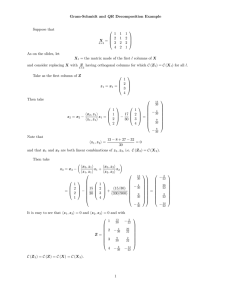
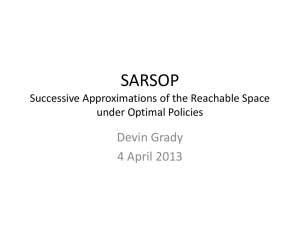

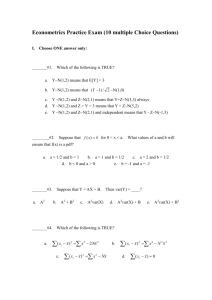
![Job Evaluation [Opens in New Window]](http://s2.studylib.net/store/data/009982944_1-4058a11a055fef377b4f45492644a05d-300x300.png)
